Not a day passes that I don’t utter an imprecation — as Julian Simon Barnes did in print a few days back — at agrobiodiversity. Take yesterday. There’s a big meeting going on this week at FAO, and they’ve set up a series of stands in the atrium. Most of them are pretty boring, just piles of publications and the odd poster, but the one put up by the people behind the International Year of Natural Fibres is very nice indeed.

It has examples of handicrafts and other products made from a whole lot of different fibres, from abaca to muskox. Including ramie. And that’s when I cursed the neverending-ness of biodiversity. For what, pray, is ramie? I know abaca and muskox, but I’d never heard of ramie.

Well, it turns out to be Boehmeria nivea, a shrub in the nettle family widely cultivated in East Asia since antiquity for its bark, which is used to make fabrics. The IYNF website has a page about it. The Korean national costume (the hanbok) is made of ramie cloth, so we’re not talking about a minor, obscure, criminally underused plant here. Bloody agrobiodiversity indeed. I hate you.
You should have asked me — or read the labels inside your cheaper clothes. The use of ramie, especially mixed with other natural fibres such as cotton and linen, rocketed in the 1980s as a result of trade rulings on the import quotas for various types of fabric. Ramie: Old Fiber – New Image is a reasonable starting point. But don’t go there, unless you want to disappear down the rabbit hole of international trade regulations.
I don’t wear cheaper clothes.
@Luigi – Depends on your comparator. Some of your clothes must be cheaper than others (of your clothes), although they may not be cheaper than my clothes.
One thing I discovered a while ago when looking up ramie was that nettles themselves (Urtica) contain fibre that can be used in weaving. Nettle fibre isn’t used so much currently because, to be honest, it’s kind of rubbish, but it did have a usage spike in Britain during World War II when better-quality materials such as linen were in short supply.
@Christopher Taylor – Amen to the fibres in nettles. Last time Luigi nibbled nettles I was prompted to write a little thing myself about cutting down nettles. A sharp scythe, that’s what one needs. None of this sodium chlorate rubbish. As Eric well knew.
Julian Barnes? didn’t know he’s in biodiversity also :-)
May well be, for all I know. Ornithology, at the very least. But thanks, slip corrected.
Luigi: In the ‘good old days’ Kew Gardens had an interest in economic botany — mainly to support crops that could be add value to colonial agriculture. Ramie figures in the fascinating contents of the second volume of the Bulletin of Miscellaneous Information of the Royal Botanic Gardens, Kew. Vol. 1 1887: Teff; Oil of ben; Cape boxwood; Hemps – Mauritius, Sisal, Manila etc.; Annatto (Bixa) tree tomato; Choco (Sechium); Arracacia; Mexican whisk; Introduction of brazil nut to Australia. Vol. 2 1888: Colonial fruit; Fosteronia rubber; Patchouli; Vanilla; Ureras fibre; Tea; Ipecacuana; Brazilian gum arabic; Shantung cabbage; Job’s tears; Star anise; Tea oil; Demerara pink root; Yoruba indigo (Lonchocarpus cyanescens); Ramie (Boehmeria nivea); Copal, Jamaica India-rubber (Forsteronia floribunda).
I seem to remember that ramie fibre was brought to England for trials on processing (it’s gummy). I’ve seen it growing somewhere ‘out East’, Indonesia or Taiwan.
As an economic botanist I admit to never having heard of some of these species. And this ‘Bulletin’ became ‘Kew Bulletin’ – fine for taxonomists but of little use for economic crop production.
hi i am looking for examples fo ramie and linen fabrics